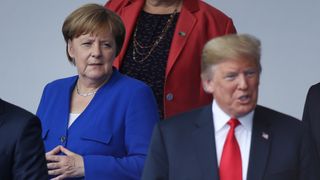As President Trump concluded his whirlwind visit to Europe, the dominant themes in the commentary of his trip include disbelief, outrage and concern. The president has yet again demonstrated that his foreign policy credo sees alliances as burdensome, long-standing special relationships with like-minded states as a relic of the past, and authoritarian regimes as legitimate and worthy of special summits.
No one was under any illusion that the 2018 NATO Summit would be a love fest after last year's failure by the president to declare his commitment to Article 5 of the North Atlantic Treaty, and particularly not after the way the most recent G7 summit ended. Yet, it was probably worse than most expected. Before even departing for Europe, the president signalled he was most looking forward to the last leg of the trip – his meeting with Russian President Vladimir Putin, whom he deemed to be easier to deal with than European allies.
This statement perfectly foreshadowed what his week in Europe would look like. Shortly after landing in Brussels, the president went after the majority of NATO allies who have not been meeting the target of 2 per cent of GDP on defence spending, as was agreed at the 2014 NATO Summit in Wales. The meeting of NATO leaders proceeded with a sense of crisis in transatlantic relations, only to find resolution with President Trump’s announcement that they have all agreed to the new defence spending commitments and proclaiming great victory (which to date remains uncorroborated by the NATO allies).
President Trump’s criticism of Germany stood out the most, as he accused it of being “totally controlled by” and “a captive of Russia”. A lot has already been said about this being a somewhat failed attempt to deflect from the ongoing Russia probe. However, the substance of his verbal attack against Germany is indicative of the changing US policy in Europe.
Namely, President Trump is known to look at security alliances through the prism of trade balance. In that vein, Germany is ‘guilty’ of not spending more on defence and at the same time running a sizeable trade surplus with the United States. Playing into this is the issue of Germany’s energy imports and the ongoing (and controversial) Nord Stream 2 project that is meant to bring Russian gas to its shores via the pipelines laid in the Baltic Sea.
The Trump administration has been adamant about making Europe, particularly the east of the continent, the prime market for the US liquefied natural gas (LNG) exports. During last year’s trip to Europe, Trump told the leaders of the 12 Central and Eastern European states in Warsaw: “We are sitting on massive energy and we are now exporters of energy. So, if one of you need energy, just give us a call.” His remarks came after the first ever shipment of the US LNG to Eastern Europe and as the projects for building new LNG terminals in Southeast Europe are underway.
Since 2014, the Obama administration strongly argued for diversification of energy sources and LNG exports as a geopolitical instrument to offset Russia’s influence on the continent that is still highly dependent on Russian gas. On the other hand, the Trump administration sees energy exports mostly as a trade instrument that is conducive to the ‘America First’ agenda of trade deficit reduction and job creation at home. It is telling that the president did not mention some of the usual geopolitical concerns regarding the Nord Stream 2, which revolve around isolating Ukraine, as well as a number of Central and Eastern European states. The message this sends to allies and partners is unequivocal: you are safe as long as it fits the US bottom line.






